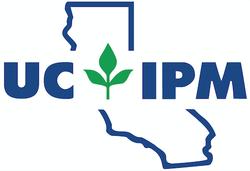
2022 Elinor Teague past articles
Elinor Teague

October 2022 MG website column by Elinor Teague
Forecasters are predicting a greater than 60 per cent chance that we’ll have a third consecutive year of La Nina conditions with heavier than normal rain in the Northwest and continuing severe drought in the Southwest of the U.S .The average annual rainfall in the Fresno/Clovis area over a twenty-year period has been 11.5 inches; so far this rain season we have received only 6.4 inches of rain.
With the possibility of another drought year ahead, Central Valley gardeners continually need to adapt to changing and difficult growing conditions. Weather patterns this summer were unpredictable. We experienced extreme temperatures under heat domes as well as very heavy and unusual summer rains from atmospheric rivers. Summer vegetables and annuals stopped flowering and leaves burned to a crisp during extreme heat in June and again in late August and early September. Rain after the heat spikes led to problems with fungal problems, causing leaf damage followed by leaf fall. Leaves on heat-stressed mature landscape trees including Japanese maples and sycamores are dropping prematurely this autumn as well.
Premature leaf fall is a serious problem whether it’s caused by disease or by weather. Leaves provide shade and food for plants and remove carbon dioxide and pollutants from the air. When crop-producing plants and trees lose their leaves before harvest in summer, the fruits shrivel in direct sun.
Preventative measures can be taken to control for fungal diseases by removing any affected leaves as soon as the disease is noticed and placing the leaves in the green or organic waste bin rather than the compost pile and by spraying smaller plants with anti-fungal horticultural oils like neem oil or jojoba oil when rain is predicted. Deep irrigation of large landscape trees at least monthly until cold weather arrives is critical. It won’t be easy to determine whether a tree that lost its leaves prematurely has entered dormancy before pruning this year. Stressed trees should be pruned lightly to remove only dead and diseased wood and shaped to preserve as large a canopy as possible.
Our usual autumn planting season begins in late September and early October when we take out summer annuals and vegetables even if they’re still producing flowers and fruit and then set out transplants or put in seeds of cool-season plants. Exactly when to do this is a little uncertain this October. If we go by last year’s heat records, temperatures in November were still warm until Thanksgiving. We risk having cool-season crops that were planted in early October bolting in fall heat. So do we postpone fall planting a week or two hoping for cooler weather to ensure that plants will have a better chance of good root development so that they will have a vigorous growth period in late January (our early spring here in the Central Valley? Or do we take a chance and stick to the accustomed planting times but plant only heat-tolerant and slow to bolt varieties?
With another drought year predicted this will not be the best time to reconfigure your garden to provide as much afternoon shade as possible by planting trees and bushes on the western and southern sides of the property. However, it can be a good time to observe sun and shade patterns and to amend the soil to improve water retention. Shade will become priceless if these severe weather conditions continue.
September
September 2022 MG website column by Elinor Teague
Last year (2021) the Fresno/Clovis area experienced more than 64 days of temperatures above 100 degrees, well over the annual average of 38 days. The final tally of 100 degree days for this year may match or even exceed that of last year. Although Central Valley gardeners are accustomed to dealing with high summer temperatures, the recent extended periods of excessive heat are proving difficult and frustrating. The necessity of water conservation as the mega drought continues adds to every gardeners’ dilemma.
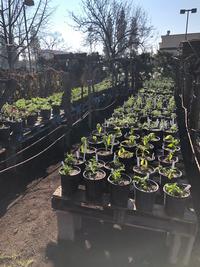
Central Valley gardeners will need to adapt to the changing planting schedule. Fresno and Madera County Master Gardeners may want record their observations of the results of this fall’s plantings along with relevant temperature records to share with the community.
Here are a few suggestions for collecting information for anecdotal records.
Blossoms fall off fruiting plants and flower buds fail to develop fully when temps are above 90 degrees. When temperatures are above 96 degrees, plants’ metabolic processes slowdown. As nights grow longer and temperatures cool in late August, fruit set and flower bud set normally should resume. Did tomatoes, beans, squash, cucumbers resume flowering and setting fruit later this fall? Did roses produce a full crop of well-formed flower buds as usual in early September or was bud set delayed?
Temperatures the first week of September were predicted to be above 105 degrees for several days in a row. What condition were landscape plants in after that heat spike? If any of those plants were in good enough condition to be transplanted, were they able to recover vigor after transplanting and how quickly did they recover? How many heat spikes were there this fall and how did well-established plants respond to the continued heat? How did seedlings and new transplants respond to later heat spells.
Many gardens have some planting beds that have been well-amended with compost and humus regularly as well as beds that are less well-amended, perhaps consisting of mostly native soil. Were any differences noted in water retention rates, water drainage and plant condition in planting beds during the fall planting season? How were watering schedules adjusted according to the weather?
We have been able to plant and transplant many spring-blooming annuals and cool-season crops in fall for flower display and food in late fall and very early spring because moderate fall temperatures encouraged good root development before winter. If planting and transplanting had to be delayed from mid or late September until mid or even late October by excessive heat, did plants and seedlings have enough time to establish good root systems before soil temperatures dropped below 50 degrees? You might need to pull out a few small transplants to estimate the extent of the roots’ development.
Master Gardener’s website column August 2022
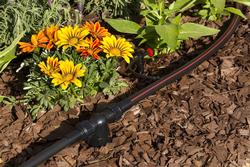
Master Gardener’s website column JUNE 2022

Identification of the pest insect usually begins with identifying the type of damage, the location, size and appearance of the damage. Careful observation helps us differentiate between damage cause by a chewing insect (snail, slug, hoplia beetle, squash bug) or a sucking insect ( Bagrada bug, aphid, whitefly, scale).
For example, when trying to identify the pest insect that’s eating holes in your rose leaves is the hole in the middle of the leaf or at the edge? Is it a raggedy hole or does the hole have a fairly smooth edge? We don’t always see the pest or recognize it as the culprit when we do see it. The success of pest control methods and the timing of application of the control method depend on accurate identification.
There are several common summertime pest insects that are not always easily identified by home gardeners even though the damage they cause is obvious.
Leafcutter bees are not considered true pests but the unsightly damage they leave behind when they cut out clean-edged semi-circles from rose and other plant leaves worries many gardeners. Female leafcutter bees use the leaf sections to line their nest cells. Because leafcutter bees do not ingest the leaf tissue pesticides are ineffective. These are solitary, non-aggressive bees who do their work at dusk and they are important pollinators. The damage to the plants is not serious and the bees deserve our protection from pesticides.
Rose slugs are not slugs and although they look like small half-inch long bright-green caterpillars, they’re not caterpillars. Their coloration makes them nearly invisible on the leaves but their black heads mark them as the larvae of the sawfly, a type of wasp, and they feed on rose leaves, skeletonizing and chewing holes the middle of the leaves. Rose slugs can be picked off or controlled with narrow-range oils, neem oil, insecticidal soaps, but not with Bt since they’re not caterpillars.
Leafminers are the larvae of small flies that lay their eggs in warm weather to hatch between leaf surfaces of many types of plants including citrus trees. As the eggs hatch and the larvae begin to feed they create meandering trails within the leaf tissue that eventually become visible as the larvae grow bigger. The first signs are often large white spots on leaves when the trails or mines have congregated. Leaf miner damage rarely is serious enough to harm the plants and pesticides are not very effective in killing the larvae feeding within the leaf tissue. Remove infested leaves and keep plants healthy and well-watered during the summer growing season.
Master Gardener’s website column May 2022
April brought us much-welcome showers and delightfully moderate springtime temperatures. It also brought problems with powdery mildews as well as an extended season of cool-season weeds as well as a proliferation of seedlings of invasive plants.
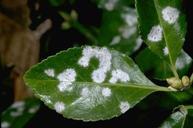
Most gardeners recognize the signs of powdery mildew on roses. Buds and more tender stems are covered with what looks like a white powder that can be rubbed off with fingers. The first spots of powdery mildew enlarge and grow together to completely cover the buds and stems. Buds become deformed and fail to open and tender stems twist.
However, symptoms vary with the plant species and are not always easily identified. Symptoms are more severe in plants that are shaded or planted in spots with poor air circulation. IN my small garden, last year’s still vigorous pepper plant, “Johnny Nardello” shows yellow, chlorotic mottling on just a few of last year’s leaves; new leaves and flower buds are so far unaffected. The yellow mottling on vegetable leaves caused by powdery mildew is also common to eggplants and tomatoes.
The sage leaves have just a light, nearly invisible coating of white dust. Experience has shown that within a few weeks, dry brown spots will develop on the sage leaves followed by holes or sometimes by skeletonization of those areas. It’s easy to mistakenly assume that the damage was caused by insects feeding on the leaves.
Several coreopsis plants show a white coating on leaves which are also quickly developing a bumpy surface. The one that gets the most sun seems to be much less affected than the one that gets the most shade. It’s predictable according to observations from past year that in a few weeks the coreopsis leaf tips will turn brown, looking as though they were insufficiently watered.
Treatment for powdery mildews begins with washing as much of the white powder or fungal spores off as possible. Do this in the morning to allow leaf surfaces to dry before nightfall. Our intense summer heat will kill off many of the fungal spores. Sulfur products are only effective as preventative measures for powdery mildews. Horticultural oil or plant-based oil sprays, especially neem oil sprays can be used as preventatives for powdery mildew as well as for control. Read labels carefully and be prepared to repeat applications frequently. Remove infected leaves, stems and buds and dispose of them in the green waste bin.
Fertilize infected plants lightly with lower-nitrogen foods that will not encourage rapid green growth.
Weed seeds and the seeds of invasive landscape plants remain viable for years on the soil surface and on top of mulches. After spending hours hand-pulling invasive seedlings in late February and March before they set seed in my yard (notably characias and Mexican feather grass) another crop appeared in my yard and in my neighbors’ after April showers. More hand-pulling and another layer of mulch are continuing chores until the heat arrives.
Master Gardener’s website column April 2022
April 2022 MG website column by Elinor Teague
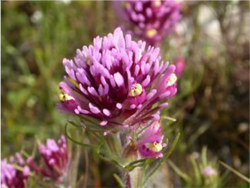
Creating a drought-tolerant garden is fairly easy when you start with a yard or space with no other existing plants or lawn. But what if, like so many home gardeners, you are trying to install a drought-tolerant garden in a space that contains large, mature landscape trees and well-established plantings that are somewhat drought-tolerant? Or with an irrigation system that needs a complete revamping to serve your new landscape design and to conserve water? or with a combination of soil types that drain differently or that don’t retain water well? or with a large bermuda lawn area? That’s when putting in a drought-tolerant garden can become really complicated.
Shade-producing and carbon-reducing large mature landscape trees are too precious to have removed just for design purposes. Often the first decision involves working around a tree’s need for deep, slow irrigation. Large trees need deep irrigation at least monthly during the late fall and winter months depending on rainfall frequency and amounts. During the bone dry, intensely hot summer months here in the Central Valley large landscape trees and fruit and nut trees may require weekly deep irrigation to maintain soil moisture at a depth of 12 inches. Automatic drip irrigation systems can be designed to deliver water to separate zones which contain groupings or mass plantings of plants with similar water needs. Big trees’ need for deep irrigation doesn’t always match that of nearby plantings. Either design or revamp irrigation systems to place large trees in their own irrigation zone or use supplemental watering devices like soaker hoses on hose-end timers to deep irrigate.
Don’t be in a hurry to remove all existing plantings. Some English garden plants including azaleas and camellias are surprisingly drought-tolerant when established and when well-mulched. Old-fashioned hedge plants like myrtle and for are also very hardy. Do a little research first and try to incorporate healthy vigorous mature plants into your design.
Many gardens in the Central Valley are made up of patches of differing soil types. Before starting to plant test the drainage in a 12-inch hole in several spots in the garden. The water in clay soil may take an hour or more to drain; water in sandy soil may take a few minutes, up to an hour; and if there is an underlying layer of hardpan or baked clay the water may never drain.
Amending the soil before planting to improve soil texture, drainage and water retention and to add beneficial micro organisms and fungi is critical to growing healthy plants. In both sandy and clay soil areas lay down at least a four-inch layer of compost or humus and turn it into the soil. Take advantage of differing soil types by putting succulents in naturally sandy areas and California natives that can tolerate heavier soil in clay soil areas. Side dress plants with compost during the growing season.
Bermuda grass can be nearly impossible to eradicate. Soil solarization works after scalping the pre-existing lawn but it can take several attempts over several hot summers to get real control of Bermuda grass. Weed barrier cloth can be played down under mulches or DG toppings to help thwart Bermuda. Herbicides should be used sparingly, if at all, and are no longer recommended for more than spot control of weeds and Bermuda gra
Master Gardener’s website column March 2022

No one really expected the mega drought that began in the year 2000 to last this long. In order for plants and trees to survive long term severe drought conditions all gardeners need to focus on the creation of healthy soil that can sustain plant growth with much less water It seems as though drought conditions will continue to be the norm in California for quite a while. As California Master Gardeners we are fortunate to have access to the latest research by UCDavis into the creation of healthy soil.
Much of the latest research has been directed to changing large-scale agricultural practices including conservation tillage (fewer passes with the tractor) as well as the effects of soil amendments in increasing water retention rates in soil and increasing carbon sequestering in the soil as a means of reducing carbon levels in the atmosphere.
Master Gardeners and home gardeners can glean a lot of useful information from recent research publications that can easily be applied to home gardening practices.Here are two primary examples.
-home gardeners can create healthier soil in their gardens by regularly adding compost or humus, at least 30% by volume before each spring and fall planting season. Healthy soil is dark, fluffy, sweet-smelling and, if squeezed when damp, holds its shape lightly.
Healthy soil is a living ecosystem that contains millions of beneficial micro organisms, beneficial bacteria and fungi that can improve soil structure and drainage, control disease pathogens, reduce the need for fertilizers and pesticides, moderate soil temperature fluctuations and increase the ability of roots to absorb water. -overtilling the soil destroys the soil structure and cuts through fungal hyphae or threads that extend long distances, absorbing and retaining water.
Home gardeners can make it a practice to gently turn in amendments twice a year and then leave the soil undisturbed.
Sources:
“PAY DIRT:Fighting global warming with a ‘dirty’ strategy.January 20, 2006, www.ucdavis.edu/news/pay-dirt-fighting-global-warming-'dirty'-strategy
Composting is Good for Your Garden and the Environment”, Pam Geisel and Donna Seaver, September 2009, https://anrcatalog.ucdavis.edu
“The Latest Dirt-Research-based Innovation in Soil Health”. Symposium, October 15th, 2016, www. ccuh.ucdavis.edu
“Uncovering the Hidden Life of Soil,February 27, 2017, https:://research.ucdavis.edu/uncovering-hidden-life-soil-2/
Note:
flower and vegetable seeds are in short supply again this year.Nursery and garden racks were nearly empty in January and February and online seed suppliers have a limited supply with shipping delays that affect transplant timing.Here in the Central Valley we start seeds for transplants of summer vegetables and flowers six to eight weeks later in mid to late January for transplant into the garden in mid to late March or early April. Delays in seed shipping will mean that tender seedlings will not be ready for transplant until at least late April, just as our weather heats up.
Seeds of heat and drought-tolerant varieties and those flowers and vegetables that attract pollinators and birds are most in demand.
Seed shortages have become an annual problem.
Save your seeds, share your seeds with fellow gardeners and start a few extra transplants to share as well.
Master Gardener’s website column February 2022

Master Gardener’s website column January 2022


